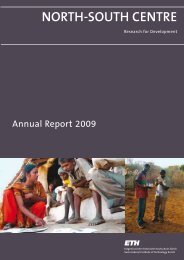Annual Report 2006/07 - ETH - North-South Centre North-South ...
Annual Report 2006/07 - ETH - North-South Centre North-South ...
Annual Report 2006/07 - ETH - North-South Centre North-South ...
Create successful ePaper yourself
Turn your PDF publications into a flip-book with our unique Google optimized e-Paper software.
Research Fellow Partnership Programme (RFPP)Research fellow (Post-doc)Changhu Wang, CIAT, ColombiaSupervisorsZaida Lentini, CIAT, Colombia /Peng Zhang, <strong>ETH</strong> ZurichCollaboratorsHernán Ceballos, Zaida Lentini,CIAT, ColombiaDurationJanuary 2005 – December 20<strong>07</strong>Development of an protocol for the productionof cassava doubled haploids and its use in breedingThis project aims to develop a protocol for the production ofdoubled-haploids from anther or microspore cultures incassava. The thick and auto-fluorescent exine walls of cassavamicrospores hinder the use of fluorescence staining fordevelopmental stage examination and subsequent cell divisionmonitoring. A histological study was conducted on themicrosporogenesis, generating useful knowledge for theidentification of the most responsive microspore stage forandrogenesis, i.e. the late uninucleate to early binucleatestage as revealed in most model systems. The processes ofmicrosporogenesis and the sporopollenin deposition in theexine were analysed using electron microscopy. The microsporesat the late uninucleate to early binucleate stage incassava are characterised by (i) an oppressed significantlyreduced cytoplasm, harbouring the nucleus/nuclei with oneor two nucleoli, (ii) one or several large vacuoles, accountingfor more than 95 % of the cell in volume, and (iii) welldevelopedexine walls with strong auto-fluorescence. InHMC-1 and TAI-8 cassava clones, this stage of microspore iscontained in flower buds of 2.5 – 2.6 mm in diameter,collected from field-grown plants during the rainy season.Different treatments were tested to induce microspore division, the first step for standardisation and development of areproducible haploid technology. Some microsporesincreased their volume about fourfold (enlarged microspore,EM) compared to “uninduced” microspores. EM is usuallyassociated with the acquisition of embryogenic potential inmodel systems. Optimal treatments reproducibly induced20 % of EM in the culture. In some cases, multi-cellular structures,embryo-like structures and microcalli were observedindicating more advanced structures than EM.Two students participated in the project in <strong>2006</strong>, GodwinAmenorpe, a cassava breeder from the Ghana AtomicCommission, and Zhu Wenli from CATAS, <strong>South</strong> ChinaUniversity for Tropical Agriculture.Detail of a microspore at the late uninucleate to early binucleate stage, showingthe vacuole (V), nucleus (N), nucleolis (arrow) and exine (E)50
















